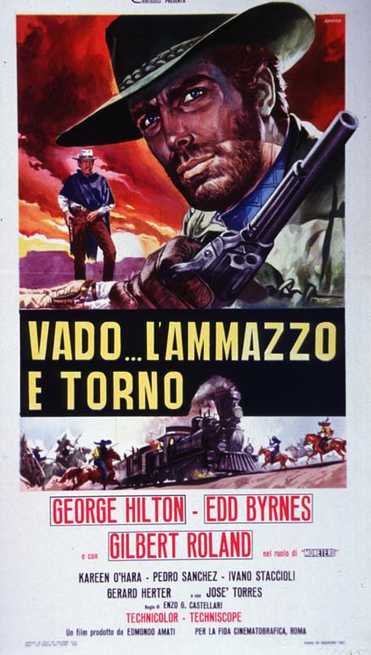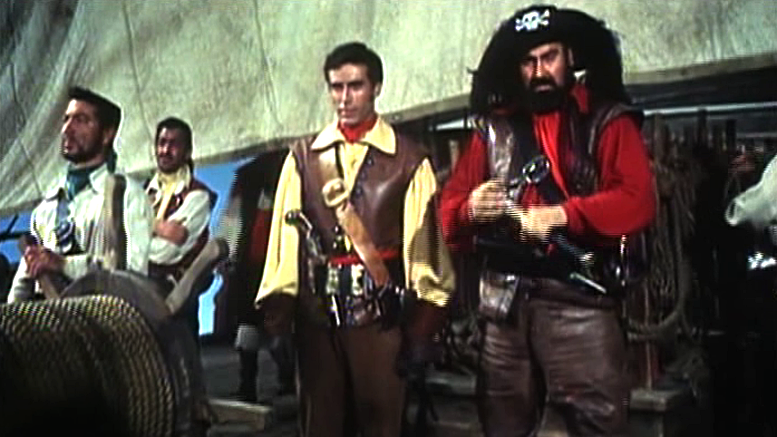aka Vado… l’ammazzo e torno (It), Je vais, je tire et je reviens (Fr), Leg ihn um, Django! (WG), Go Kill & Come Back (UK video), Rio Bandidos (WG, Super 8mm title)
1967
Italy
Edmondo Amati for Fida Cinematografica
Director: Enzo Castellari
Story: Romolo Guerrieri [Romolo Girolami], Sauro Scavolini
Script: Tito Carpi, Giovanni Simonelli, Enzo Castellari
Music: Francesco De Masi, Alessandro Alessandroni
Cinematography: Giovanni Bergamini {Techniscope – Technicolor}
Editor: Tatiana Casini
Set design: Alberto Boccianti
Cameraman: Salvatore Caruso
Filmed: Cinecittà
Release information: Registered 19.09.67. Italy (26.09.67), France (10.07.68, 100 mins), West Germany (28.03.69, 96 mins)
Cast : George Hilton (‘The Stranger’), Gilbert Roland (Montero), Edd Byrnes (Clayton), Kareen O’Hara [Stefania Careddu] (Marisol), Pedro Sanchez [Ignazio Spall] (Pajondo), Gerard Herter (Blackman), Ivano Staccioli (the Captain), Jose Torres (Bahundo), Valentino Macchi (Charro Ruiz), Adriana Giuffre (Conchetta), Rick Piper [Riccardo Pizzuti] (the undertaker), Rodolfo Valadier (Pablo), Mario Mariani (the sergeant)

This film once again demonstrates Enzo Castellari’s frustrating habit of devaluing his own films by showing an over-reliance on acrobatic choreography. This is particularly irksome in this case because, unlike some of his westerns (Sting of the West (Te deum, 72) and I Came I Saw I Shot (I Tre che sconvolsero il West – vado, vedo e sparo, 68), for example) there’s a great deal of promise on show – prefiguring the more assured touch that he would demonstrate with Keoma (76). Maybe it was a lack of confidence that swayed him into shattering the well developed mood of the fist half of the film by following it with a series of fist fights and general antics that would be better suited to the ring than the cinema. Or maybe his pugilistic background predisposed him to discard atmosphere and plot in favour of pure blooded physical action. Whatever, it is a shame because at times Any Gun Can Play gives the impression that it could be a very good film indeed.
It’s all a basic play on The Good the Bad and the Ugly, with three diverse characters forming a series of uneasy alliances in their pursuit of a hidden treasure. George Hilton is The Stranger, a Clint Eastwood type bounty hunter who always appears at the most (in)convenient of times. Gil Roland is a more dignified bandito than Eli Wallach’s Tuco, but nevertheless holds all the attributes of the Mexican clan leader that have become familiar from the genre. Edd Byrnes, the third part of the triptych, can’t really be compared with Lee Van Cleef ‘s Ugly except for the way in which he utilises the structures of society to further his own illicit causes. None of them are strictly sympathetic or unsympathetic – at one point Hilton says “After all, when it all comes down to it everyone’s out for themselves,” which seems to be the motto that lies at the heart of the narrative.
Further accentuating the parallels are scenes of almost direct pastiche. The opening sees three characters dressed to look like Eatwood, Van Cleef and Franco Nero’s Django riding into a wind scarred town, only to be shot down by another mercenary killer. At one point two characters observing something else through binoculars become aware of each other in a sequence that is straight out of For a Few Dollars More. If this was a more contemporary film it would be explained as ‘post-modern inter-referentiality’. As it is, it stands more as an example of the self-cannibalisation and innate sense of play that runs throughout Italian genre cinema.
Overall, Any Gun Can Play is a worthy but failed experiment. There’s something good trying to escape from the shackles of an immature director (and Simonelli’s script writing credit indicates that any level of gravity is likely to be chipped down anyway). I know it has become customary to proclaim Castellari as probably the best director working in Italian action cinema, but action needs a context or else it loses the drive which should power it forward. On the other hand, there are likable performances from all the leads – who seem to work well together – and solid support from the likes of Gerard Herter (in a rare good guy role). Francesco De Masi’s score is one of his best.

I tend to agree about some of the slapstick fights as in the bath scene. I think because Enzo was so energetic and loved the athleticism aspect of the actors he hired (Byrnes was a skilled acrobat) that he used it in his films even though it often misused or he didn’t know how to facilitate it. Still it’s a very enjoyable film and the often clipped opening of the three outlaws riding into town (doubles of Django, The Man With No Name, and Colonel Mortimer) was extremely clever. You can’t say his films ever lack excitement and action.